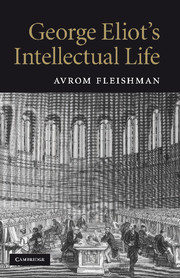Book contents
- Frontmatter
- Contents
- Acknowledgements
- Preface
- Introduction
- 1 The “Evangelical”: starting out in a Christian culture
- 2 The Apostate: moving beyond the Christian mythos
- 3 The Journalist: editing, reviewing, shaping a worldview
- 4 The Germanist: balancing the counterweight of German thinkers
- 5 The Novelist: mixing realism, naturalism and mythmaking
- 6 The Historian: tracking ideals – utopian and national – in Romola and The Spanish Gypsy
- 7 The “Radical”: taking an anti-political stance in Felix Holt
- 8 The Encyclopedist: transcending the past in Middlemarch
- 9 The Visionary: transmitting ideals in Daniel Deronda
- 10 The Intellectual: cultural critique in Impressions of Theophrastus Such
- Notes
- Works cited
- Name index
5 - The Novelist: mixing realism, naturalism and mythmaking
Published online by Cambridge University Press: 05 April 2010
- Frontmatter
- Contents
- Acknowledgements
- Preface
- Introduction
- 1 The “Evangelical”: starting out in a Christian culture
- 2 The Apostate: moving beyond the Christian mythos
- 3 The Journalist: editing, reviewing, shaping a worldview
- 4 The Germanist: balancing the counterweight of German thinkers
- 5 The Novelist: mixing realism, naturalism and mythmaking
- 6 The Historian: tracking ideals – utopian and national – in Romola and The Spanish Gypsy
- 7 The “Radical”: taking an anti-political stance in Felix Holt
- 8 The Encyclopedist: transcending the past in Middlemarch
- 9 The Visionary: transmitting ideals in Daniel Deronda
- 10 The Intellectual: cultural critique in Impressions of Theophrastus Such
- Notes
- Works cited
- Name index
Summary
In a brief memoir, “How I Came to Write Fiction,” George Eliot puts forward a familiar writerly topos, the notion that the writer was always disposed to become one, i.e., that the vocation is somehow part of his character or destiny: “It had always been a vague dream of mine that some time or other I might write a novel …” (p. 289). She grants that the idea showed stages of growth: “my shadowy conception of what the novel was to be, varied, of course, from one epoch of my life to another” (p. 289). Other indications of a subtle process at work are given in the account of Lewes's encouragement, approving of an earlier exercise and saying, “‘You must try and write a story’” (p. 289). This encouragement has led to his reputation as the “onlie begetter” of Eliot's fiction, but I venture the supposition that his stimulus, equally laudable and potent, was of another kind. They needed the money.
Returning from Germany in March, 1856, the Leweses (to give them a fictional but convenient name) found themselves without steady jobs: she had long before resigned her editorship at the Westminster Review and his relation to the Leader had fallen into abeyance. Both still had work to do on current projects, he to polish and publish his Life of Goethe, she to finish her translation of Spinoza's Ethics.
- Type
- Chapter
- Information
- George Eliot's Intellectual Life , pp. 93 - 111Publisher: Cambridge University PressPrint publication year: 2010

